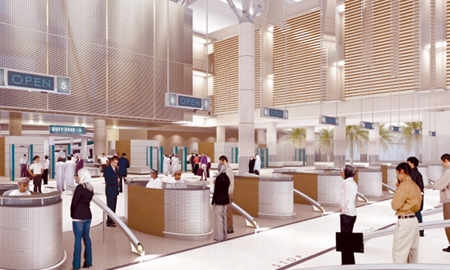A functional transportation network and well-developed infrastructure are critical for an export-driven and tourism-orientated country like Oman, therefore making investment in infrastructure is a priority and necessity with regard to the country’s 2020 vision.
Now, Oman is embarking upon the implementation of major projects linked to the building of roads, seaports, airports and rails.
Dr Ahmed Mohammed Al Futaisi, Minister of Transport and Communications, explains the benefits this growth will bring.
“We hope that by 2016 all of these mega projects will be operative because such a major transformation of our transport network will contribute greatly to Oman’s economic development by boosting trade and economic activities on one side, and providing jobs for our people on the other,” said Dr Al Futaisi.
There are currently six airports under construction in Oman, two of which are international (Muscat and Salalah) and the other four (Sohar, Ad Duqm, Ras Al Hadd and Adam) will link the regions together.
Along with the airports, ports are also being developed to maintain and expand Omani maritime traditions. Under the Eighth Five Year Development Plan, $1 billion has been committed to the development of Oman’s seaports.
“We have developed major port projects like in Sohar, Salalah and Duqm and there are three others in Muscat, Shinas and Khasab. Given the Sultanate’s long coastline and strategic location at the tip of the Arabian Peninsula, Oman’s ports certainly are a key piece of infrastructure. Some 160 miles west of Muscat, Sohar is the largest industrial hub in Oman and has taken over the commercial activities that had heretofore taken place at the Port Sultan Qaboos (PSQ), which in turn will focus more on tourist traffic.
A major transformation of our transport network will contribute greatly to Oman’s economic development.
Dr Ahmed Mohammed
Al-Futaisi, Minister of Transport and Communications |
According to
Jamal Aziz, CEO of Sohar Freezone and Deputy CEO of Sohar Industrial Port Company (SIPC), Sohar was chosen as the primary location for the oil and gas industries and today offers a strong industrial base in metals and petrochemicals, as well.
Under the private management of SIPC (a joint venture between Oman and the Port of Rotterdam), Sohar Port boasts world-class infrastructure and convenient connectivity, thanks to an excellent road network and airport in the Sohar area.
The Sohar Free Zone – which has already been injected with $14 billion for infrastructure development – offers an excellent investment climate for international investors; for example, full foreign ownership is permitted.
At the other end of the country, the Port of Salalah has the advantage of lying along some of the most important global shipping lanes. Being just 14 years old, the port was built to suit the needs of modern ships. Indeed, with a quay length of 2,505 metres and a depth of 16-18 metres, it is the only one between Singapore and Europe that can accommodate S-class container ships, and consequently ranks among the top 30 container ports worldwide.
Salalah’s Free Zone, established in 2006, is already under expansion as its tenants – which include methanol plants, shipyards and petrochemical companies – are looking to expand capacity.
The once sleepy fishing settlement of Duqm, in central Oman, is the new home of a major port, dry dock and special economic zone. The port and the town are growing in conjunction, as new jobs – not only in construction but also in the industries that are opening up there, such as shipbuilding, ship repair, petrochemicals, and oil refining – attract more people from other areas in the country.
Built in the 1970s, the Port Sultan Qaboos in Muscat has seen traffic outgrow capacity. “The port in Muscat will be transformed from a commercial port (the majority of the container traffic will be transferred to Sohar) into a completely tourism-based port, providing a great boost for tourism activities in Muscat and Oman in general,” said Dr Al Futaisi.
The ports of Shinas and Khasab are smaller terminals that receive mostly tourism traffic and support the local trade and commerce in their respective regions.

0 COMMENTS